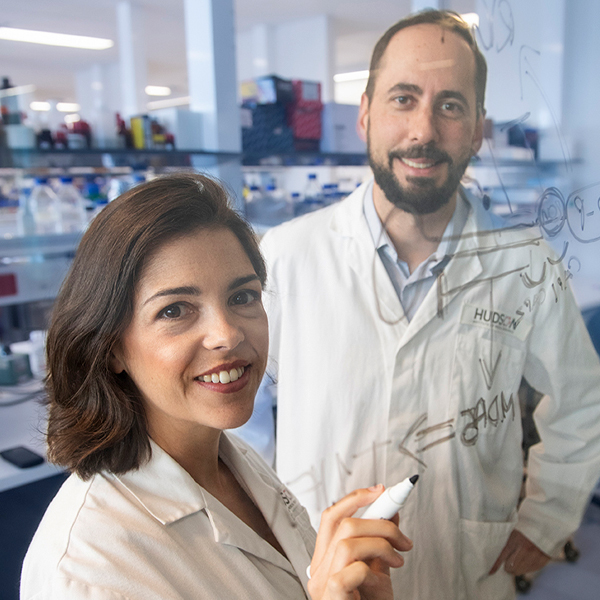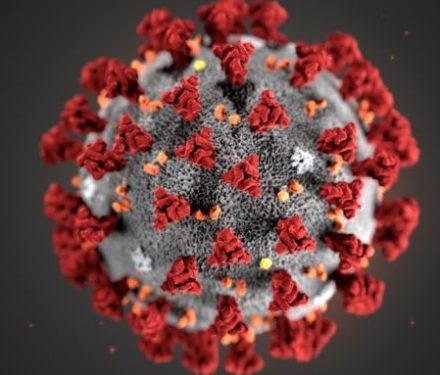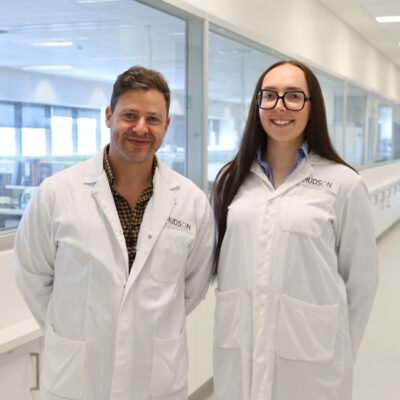RNA – changing the face of modern medicine
By Rob Clancy, staff writer
Why is RNA medicine important? And what do RNA technologies offer to human health? Associate Professor Michael Gantier and Dr Natália Sampaio share how RNA is changing medicine.

“RNA technology is changing the face of modern medicine, largely due to the speed at which new treatments, like COVID-19 vaccines, can be developed and rolled out. We’ve only scratched the surface of the potential applications of RNA therapies.”- Associate Professor Michael Gantier
“RNA therapeutics is the technology of the decade,” said A/Prof Gantier. “It opens the opportunity to treat many diseases deemed incurable to date.”
RNA therapeutics
DNA and RNA are a class of molecules called nucleic acids (the ‘NA’ in DNA and RNA). DNA contains the genetic information that controls which cells do what in our bodies and RNA converts that genetic blueprint into proteins.
Vaccines aside, RNA therapeutics are already approved to treat a growing number of diseases; for example, a twice-yearly injection for people with high cholesterol to control their condition.
How the immune system detects RNA
Dr Sampaio is leading an mRNA Victoria Activation Program Grant to better understand how the immune system detects RNA.
“If we want to employ mRNA therapies to many other diseases, like cancer or gene therapy, we need to avoid side effects to improve tolerance and safety of these therapies,” Dr Sampaio said.
RNA technology for autoimmunity
A/Prof Gantier, with a grant from mRNA Victoria, is advancing work on short anti-inflammatory synthetic RNAs (also known as oligonucleotides). The short oligonucleotide fragments at the basis of this novel technology (SofraTM) are being developed in partnership with Pharmorage Pty Ltd and could help devise the next generation of mRNA vaccines.
An additional $1.5 million from the NHMRC and $700,000 from the Victorian Government will extend RNA technology to cover autoimmunity and treatments for infection-driven hyperinflammation, such as severe COVID-19 and influenza A infection.
A/Prof Gantier was part of an international team that found a genetic cause of the chronic inflammatory disease lupus, driven by the aberrant detection of RNA, with the results published in Nature.
As for the future, RNA treatments hold promise for sufferers of a wide range of conditions, from lupus, inflammatory bowel disease and diabetes to psoriasis.
There is also the potential for mRNA vaccines that are cheaper to produce and carry fewer side effects.
READ MORE THE RNA TREATMENT REVOLUTION
Collaborators | Australian National University; Pharmorage Pty Ltd; St Vincent’s Institute; University of Melbourne; University of New South Wales; University of Technology Sydney; University of Oxford (UK)
Funders | DJPR; mRNA Victoria; NHMRC
Contact us
Hudson Institute communications
t: + 61 3 8572 2761
e: communications@hudson.org.au
About Hudson Institute
Hudson Institute’ s research programs deliver in three areas of medical need – inflammation, cancer, women’s and newborn health. More
Hudson News
Get the inside view on discoveries and patient stories
“Thank you Hudson Institute researchers. Your work brings such hope to all women with ovarian cancer knowing that potentially women in the future won't have to go through what we have!”








